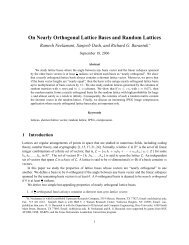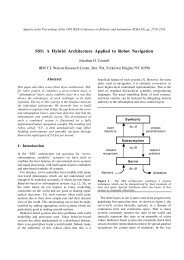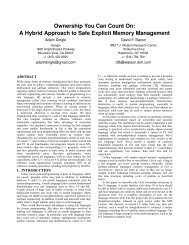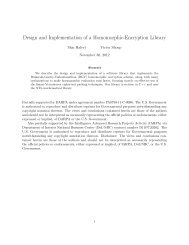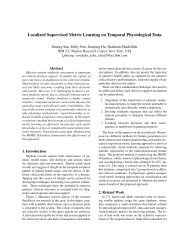SHIP: A Scalable Hierarchical Power Control ... - IEEE Xplore
SHIP: A Scalable Hierarchical Power Control ... - IEEE Xplore
SHIP: A Scalable Hierarchical Power Control ... - IEEE Xplore
You also want an ePaper? Increase the reach of your titles
YUMPU automatically turns print PDFs into web optimized ePapers that Google loves.
WANG ET AL.: <strong>SHIP</strong>: A SCALABLE HIERARCHICAL POWER CONTROL ARCHITECTURE FOR LARGE-SCALE DATA CENTERS 173slew frequency at a rate of 2 GHz in 50 microseconds [19].An industry standard voltage regulator specification forservers recommends a minimum voltage slew time acrossthe voltage range of 0.5 to 1.6 V to be no more than110 microseconds [20]. Therefore, both frequency andvoltage slew rates are well within the control period timeconstraints imposed by circuit breakers.6 EMPIRICAL RESULTSIn this section, we first introduce the physical testbed andbenchmarks used in our experiments, as well as theimplementation details of the control components. We thenpresent our empirical results to demonstrate that the <strong>SHIP</strong>hierarchical control solution can provide precise powercontrol for different power set points and when the set pointis reduced at runtime (e.g., due to thermal emergencies).We have also examined the capability of <strong>SHIP</strong> toprovide desired power differentiation and compared <strong>SHIP</strong>with a state-of-the-art centralized control solution on ourtestbed. Furthermore, we have conducted simulations tostress test <strong>SHIP</strong> in large-scale data centers using a trace filefrom real-world data centers, which has the utilization dataof 5,415 servers. Those additional empirical and simulationresults are available in the supplementary file, which canbe found on the Computer Society Digital Library athttp://doi.ieeecomputersociety.org/10.1109/TPDS.2011.93,of this paper.6.1 Testbed ImplementationOur testbed includes nine Linux servers to run workloadsand a Linux machine to run the controllers. The nine serversare divided into three groups with three servers in eachgroup. Each group emulates a rack while the whole testbedemulates a PDU. Servers 1 to 4 are equipped with 2.4 GHzAMD Athlon 64 3800+ processors and run openSUSE 11.0with kernel 2.6.25. Servers 5 to 8 are equipped with 2.2 GHzAMD Athlon 64 X2 4200+ processors and run openSUSE10.3 with kernel 2.6.22. Server 9 is equipped with 2.3 GHzAMD Athlon 64 X2 4400+ processors and runs openSUSE10.3. All the servers have 1 GB RAM and 512 KB L2 cache.Rack 1 includes Servers 1 to 3. Rack 2 includes Servers 4 to6. Rack 3 includes Servers 7 to 9. The controller machine isequipped with 3.00 GHz Intel Xeon Processor 5,160 and8 GB RAM, and runs openSUSE 10.3. All the machines areconnected via an internal Ethernet switch.In our experiments on the testbed, we use two standardbenchmarks: High Performance Computing Linpack Benchmark(HPL) (V1.0a) and SPEC CPU2006 (V1.0), as ourworkloads. HPL is a software package that solves a(random) dense linear system in double precision (64 bits)arithmetic. The problem size of HPL is configured to be10;000 10;000 and the block size is set as 64 in allexperiments unless otherwise noted. SPEC CPU2006 isconfigured with one user thread and recorded as performanceratio, i.e., the relative speed of the server to finisheach benchmark (compared to a reference Sun UltraSparc IImachine at 296 MHz). CPU2006 includes CINT2006 andCFP2006, which consist of integer and floating-point benchmarks,respectively. The reported result is the average of allthe benchmarks in each category. Note that, we use HPLand SPEC CPU2006 as our workloads because they providestandard ways to quantify the performance improvementachieved by our control solution. Our control algorithm isnot limited to the two benchmarks and can be used toachieve similar performance improvement for other workloadsin data centers.We now introduce the implementation details of eachcomponent in our power control architecture.<strong>Power</strong> monitor. The power consumptions of the emulatedPDU and three racks are measured with four WattsUp Propower meters, which have an accuracy of 1.5 percent of themeasured value. The power meters sample the power dataevery second and then send the readings to the fourcontrollers through system files /dev/ttyUSB0 to ttyUSB3.Utilization monitor. The utilization monitor uses the /proc/stat file in Linux to estimate the CPU utilization in eachcontrol period. The file records the number of jiffies (usually10ms in Linux) when the CPU is in user mode, user modewith low priority (nice), system mode, and when used bythe idle task, since the system starts. At the end of eachsampling period, the utilization monitor reads the counters,and estimates the CPU utilization as 1 minus the number ofjiffies used by the idle task divided by the total number ofjiffies in the last control period.CPU frequency modulator. We use AMD’s Cool’n’Quiettechnology to enforce the new frequency (and voltage) levelby DVFS. The AMD microprocessors have four or fivediscrete DVFS levels. To change CPU frequency, one needsto install the cpufreq package and then use the root privilegeto write the new frequency level into the system file /sys/devices/system/cpu/cpu0/cpufreq/scaling_setspeed. The AMDprocessors used in our experiments support only severaldiscrete frequency levels. However, the new frequency levelperiodically received from a rack-level power controllercould be any value that is not exactly one of the supportedfrequency levels. Therefore, the modulator code mustresolve the output value of the controller to a series ofsupported frequency levels to approximate the desiredvalue. For example, to approximate 2.89 GHz during acontrol period, the modulator would output a sequence ofsupported levels: 2.67, 3, 3, 2.67, 3, 3, etc. on a smallertimescale. The detailed modulator algorithm can be found in[8]. Clearly, when the sequence has more numbers during acontrol period, the approximation will be better but theactuation overhead may become higher. In this paper,we choose to use 50 discrete values to approximate thefractional frequency level, which leads to a subinterval of100 ms during an example control period of 5 s. Since theaverage overhead (i.e., transition latency) of changing theDVFS level in AMD Athlon processors is about 100 saccording to the AMD white paper report [21], the impact ofactuation overhead on system performance is no more than0.1 percent (100 s=100 ms), even in the worst case when thefrequency needs to be changed in every subinterval. Thisamount of overhead is acceptable to most computersystems. In addition, recent studies [22] have shown thatthe overhead of DVFS in future processors can be innanoseconds. Therefore, the overhead of DVFS is smallenough to be used in real systems even when a muchsmaller control period is adopted.




